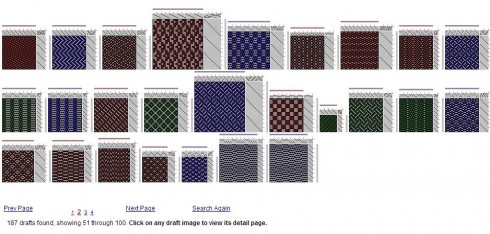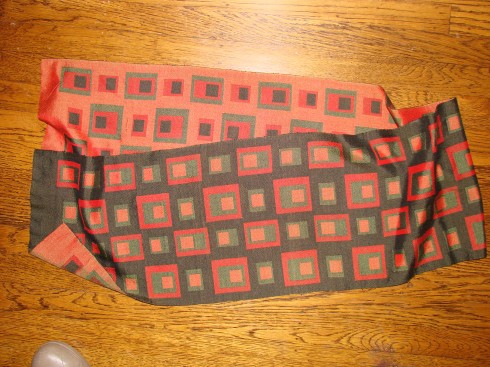If I had had to learn how to draft by filling in little boxes on point paper, I would be quilting now. I was lucky though. Sally Breckenridge introduced me to computer drafting in 1996 and I never looked back. The best thing? The immediate feedback that the computer gives as you change any element of a draft. I can move a warp thread, change a color, opt for another tie-up, change the treadling with little effort. Before I bought the software I felt tied to published drafts. Handwoven Magazine was my muse! It was useful for a period. I learned a lot about different fibers and setts and finishing. I did not learn a lot about design, I left that to the more experienced, to the “better” weaver. No, I was not weaving on 32 shafts at the time, I had a 4 shaft LeClerc and I loved it.
There is a definite learning curve to using weaving software, but it isn’t very steep. Once you start playing with it, the interactive features of the programs will almost talk to you. For example, design a block profile, then just substitute in different weave structures, the software will even tell you if you have or don’t have enough shafts for a particular structure. You will try structures you never thought about previously.
Ah, I can hear the doubters now… “but I am not a structure junkie”. Fair enough. Have you heard of www.handweaving.net? You can peruse old manuscripts, read old drafts, download them to your own computer and play. The picture below was snipped from one page of one book on www.handweaving.net. The search was for 4 shaft weaves. Note the last line of this graphic, “187 drafts found…”. Again, this is a partial display of one page of one book. Yes, some of them have too many treadles but most are quite reasonable, weaveable.
Perhaps you would like to play with color and weave. Easy to do on the computer. Set the warp up and then experiment with AB, AAB, AABB, ABC as weft order etc. Really, what’s not to like. There are so many options! Other changes possible? Change the twill tie-up with a click of a mouse, turn a draft, interchange the tie-up from one draft to another or treadling from one draft to another. It is endless.
There is free weaving software on the web if you would like to just try. Google “weaving software free” and look for the link to a Complex Weavers page that will list a number of different programs available on the web.
One of the more helpful aspects for me has been the ability to share drafts with other weavers. The universal weaving format “.wif” will allow one program to open a file from another. When you are proud of some work that you have created, or can’t find out what is wrong, sharing is very, very useful. Wif files can also make the isolated weaver less isolated. My guild only meets formally 6 times a year but I communicate with my weaving friends on a much more frequent basis via the web and weaving software. I have found this exchange to be particularly useful when exploring a new structure or just looking for inspiration.
Once you get interested in developing drafts via software there are many other tools to explore. Many are now aware of the ease of using Photoshop Elements for design, but other programs can also be used such as Paint and Corel’s PaintShop.
Designing in Photoshop offers many starting points. You could have a basic idea and using the drawing tools, it can be realized. I have also started with pictures of my own or from the internet. Sometimes it is as simple as a .gif file of a stencil that I can adapt or it could be a piece of a more complicated image. One of my first attempts at using Photoshop was designing a double weave scarf. For this project I also wanted to try using four color double weave (color A and B in warp mixing with both color C and D in weft—AC, AD, BC, BD). It was fun to play with color placement. Did I want the red to be background, or center squares or borders etc. The colors are defined by the threads.
The above are the four color combinations that I chose. It was then just a matter of play to decide where the different combinations would work best. Once that is determined, the structures associated with each color combinations are then substituted in the corresponding areas. The file now looks unreadable to our eye but my weaving program is happy.
There are now books and monographs available that will introduce non-computer savvy weavers into the wonderful world of design via computer graphics. Both Alice Schlein and Margaret Coe have written eminently readable books with clear instructions on how to use these formats. Admittedly though, you will need more than 8 shafts to take full advantage of that method of designing.
Weaving software literally changed my way of thinking about weaving. Using it freed me from just copying or making incidental changes. I began to draw, to use shapes and color schemes borrowed from the web or books and then I could morph them and add weave structures and color. I throw out many more drafts than I weave and I can do that because of the ease of using software. Yes, I do have 32 shafts now and I love it as much as I did my 4 shaft. I would still have that four shaft but for room issues!
Want to know where to go to learn more about weaving and software? Complex Weavers has a study group devoted to using computer tools and another on computer aided design. These are just a few. WeaveTech folks can be very helpful also and there is a huge searchable data base on their Yahoo site for those just starting.
Penny is a member of Loom and Shuttle, weaves on a 32 shaft Toika and designs in Photoshop. She is currently President of Complex Weavers. Other interests include kumihimo, container gardening and grandkids, not necessarily in that order.
Press here to go to next article

